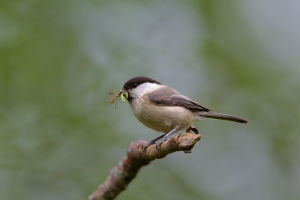Birds and butterflies struggling to cope with climate change under intensive land use
11 January 2017

Some of Britain’s much-loved birds and butterflies could be wiped out in certain areas if they do not have sufficient natural habitat to allow them to adapt to warming temperatures, a new study shows.
Scientists looked at more than four decades’ worth of bird and butterfly records from more than 600 monitoring sites around England and found that cold-associated birds like the meadow pipit, willow tit and willow warbler have already been lost from many bird communities.
We have known for some time that climate change affects individual species differently, with those associated with colder regions impacted most severely. This research, a collaboration between the University of Reading, the Centre for Ecology and Hydrology, the British Trust for Ornithology, Butterfly Conservation and Natural England, shows for the first time how habitat loss combines with climate change pressures to drive the loss of species from local areas.
Dr Tom Oliver, Associate Professor of Landscape Ecology at the University of Reading, who led the study, said: “There is a clear signature of climate change on our country’s wildlife, and for many species the situation is worse where the landscape is dominated by arable land and intensively managed grasslands. Bird communities are struggling to successfully adapt to the warming we’ve had over recent decades.
“Although butterflies are coping much better, in both cases a lack of natural habitat in our landscapes is putting cold-associated species between a rock and a hard place by limiting their ability to find resources and survive.”
The study, published in Global Change Biology, shows numbers of both cold-associated and warm-associated birds have dropped over time, but cold-associated species have declined more so as temperatures have risen and, on balance, communities are now more dominated by warm-loving species.
Dr Simon Gillings head of population monitoring at the British Trust for Ornithology, said “Loss and degradation of habitats, whether in farmland, grasslands or uplands are primary factors in reducing key resources for birds, leading to population declines. Intensive management is making it harder for cold-associated birds to find cool corners of sites, or to disperse away from warming regions, thereby exacerbating the effects of climate warming.”
Cold-weather species suffering most
Butterfly communities in northern England are gaining new warm-associated species, like the speckled wood butterfly. However, cold-associated species such as the small pearl-bordered fritillary and northern brown argus are not faring as well, and numbers are dropping in areas where natural habitat has been destroyed.
Dr Tom Brereton, head of population monitoring at Butterfly Conservation, said: “Intensive land use means fewer resources and microclimates that allow species to persist in unfavourable weather conditions. For example, warmer winters can have a negative effect on butterflies, especially those which thrive in cooler conditions.”
Researchers used bird and butterfly count data collected by trained volunteers on set recording routes from between 1964 and 2009 to paint a picture of how they have reorganised themselves in response to climate change.
The study concluded that lack of habitat has exacerbated the effects of climate change on bird and butterfly communities in parts of England. It was found to cause larger declines in birds and butterflies that are used to cold temperatures, and prevent increases in birds adapted to warm weather.
Dr Mike Morecroft, principal climate change specialist at Natural England, said: “Climate change is with us, here and now, and its effects on wildlife are increasingly well documented. This study shows that the way we manage the land can affect the resilience of our wildlife; working together to create larger natural areas in strategic places will help species to cope with a changing climate.”
The study used Species Temperature Indices, which allow scientists to order species according to whether they like cold or warm conditions, based on the locations they are found across Europe. Bird data covered 1964-2000 and butterfly data 1976-2009. Trends at different sites were compared to see how neighbouring land use affected the results.
Types of high intensity land uses investigated were arable/horticulture, improved grassland and urban/suburban land use.
Full reference:
Oliver, T.H., Gillings, S., Pearce-Higgins, J.W., Brereton, T., Crick, H.Q.P., Duffield, S., Morecroft, M.D., Roy, D.B (2016). ‘Large extents of intensive land use limit community reorganisation during climate warming’. Global Change Biology. doi: 10.1111/gcb.13587
